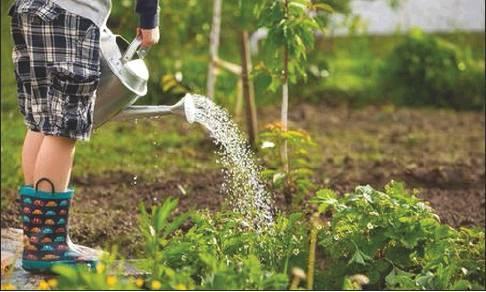Getting Into Gardening
It is getting hot, so I am bombarded by questions about watering the lawn and garden. Watering seems simple but can actually take a bit of finesse to do properly. Watering habits vary widely. Some folks are busy in their non-garden life and allow their poor plants to sit dry and thirsty until they’re withered before they get any water at all. On the other hand, some gardeners pamper their plants by drowning them in far too much water. With either extreme, you stress your plants. Stressed plants are weakened plants and weakened plants are the first to fall prey to bugs and diseases and produce fewer blooms, blossoms, or vegetables. Advice on when to water plants in the garden varies greatly and can be confusing to both the beginner and veteran gardener. But, is there a right answer to the question, “When should I water my vegetable garden?”
One common belief is that our lawns and vegetables need an inch of water per week delivered by either rainfall or irrigation. This however is not always the case. Does a garden that thrives on an inch of water in April and early May do as well on an inch of water now that we are into June and soon July? Perhaps it does in some parts of the country but not always here in Hays County. Triple digit temperatures for multiple days stress any lawn and garden, so what to do during the hot days of summer?
Understanding the water needs of our lawns and gardens will ensure greater success with maintaining them. A lawn that is properly watered can compete aggressively with weeds and avoid the stress that contributes to lawn diseases. Creating a deep root system is probably the single most important goal during hot weather. Lawns should be watered to a depth of 6 inches during each irrigation. To calculate the length of time to run irrigation, collect several empty flat sided containers and set them randomly around the yard. Run the irrigation for the length of time you are used to running it. Check the amounts of water collected in the cans and calculate the average amount. Next, dig down in the soil to see to what depth the water reached. Now you can calculate any adjustment that might be needed in water time. Let’s say you collected an average of ½ inch of water in the containers in a 15-minute time period, and the water penetrated the soil to a depth of 3 inches. You can now calculate that it would take approximately 30 minutes, or 1 inch of water to penetrate to a depth of 6 inches. Sloped yards may need this amount applied in two time periods, an hour or so apart, in order to slow down run-off on the slope. Soil depth and type play a role in water percolation rate.
Determining frequency of watering is the next step in maintaining a healthy lawn. It is important to water thoroughly, as described above, and not water again until the lawn is approaching the stress point. This stress point is seen in St. Augustine grass as the leaves “folding”, and in Bermuda and Zoysia grasses as when a footprint does not “bounce” back. This is the point at which irrigation should be timed. Spending a week or two observing your lawn and setting your irrigation accordingly will ensure a more drought-tolerant lawn. Your lawn will be better able to withstand the stress of water rationing, and your water bills will reflect this “water-wise” approach to irrigation. During a “drought year”, water periodically during the winter- grass roots are still alive and require moisture. Water in the morning so leaves will dry quickly and be less prone to disease. This is especially important in the spring and fall when temperatures are cool and brown patch fungus is prevalent.
Another important part of watering the lawn, that is often overlooked, is mowing. Remember to raise the mower height in the heat of the summer. The leaves will shade the soil and conserve moisture. Try not to remove more than 1/3 of the leaf blade each mowing. Last, but not least, try to observe your irrigation system while it is running—the reason for that brown grass may become obvious!
What about your veggie garden? When does it need watered? Again, common wisdom tells us to make sure that vegetables are getting an inch of water a week. That old rule of thumb of watering one inch per week originated from an understanding that, on average, it takes about an inch of precipitation at one time to deliver enough moisture to the deep root zone. In fact, this is not the case. For example, clay-based soils hold more water than sandier soils, so an inch of water a week could result in overwatering.
Do you feel any guilt when you notice your veggies wilt? Well get over it! The temporary wilting often observed during the heat of midday does not mean that it’s time to water. Some plants go through an obvious midday slump, which is an indication of the plant’s natural adaptation to its environment. Visit your garden again in the morning and see if they are looking better. If they have come back and are looking perkier then they do not need water.
Don’t baby your crops: Plants are incredibly adaptable. They have the ability to draw water from deep in the soil. Periodically, take a trowel and dig down several inches into the zone where the roots are most active. If the soil there is still moist, there would be no benefit from watering.
What you want in a healthy plant is deep root penetration, and the only way that you’re going to get deep roots is if there is water down deep. Start at the very beginning: Saturate each plant hole when you transplant your seedlings. When you do water, make sure that you get the soil saturated enough that the moisture percolates several inches down. If water starts to run off move on to another plant and allow the soil to drink up the water before you return and finish giving the plant a deep watering.
Believe it or not, sometimes the best time to water is immediately after a rainfall, particularly if the rain shower only amounts to a half-inch or so of water. The reason for this is that you want to add sufficient water at the same time to ensure penetration down to 5 or 6 inches. If you wait another day or two to water, you will be adding only surface water, which evaporates rapidly. With only frequent, light watering (or rain showers), you never build up the reserve of water deep in the soil that your vegetables need to produce at their best. Us a bit of common sense and DO NOT go out in water during a thunderstorm or when there is lightning in your area.
Mulch your garden with two to three inches of mulch, water deeply and even water in the rain and your vegetables will love you as much as you love them.
Joe Urbach is a certified Texas Master Gardener from Hays County. Urbach serves the association as the director of training. He also teaches and lectures on gardening, health, and nutrition, regularly and can often be found speaking at local nurseries, libraries, garden clubs and Extension offices.



